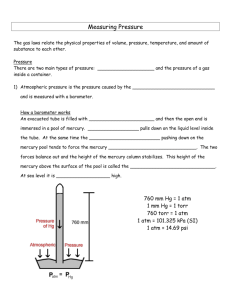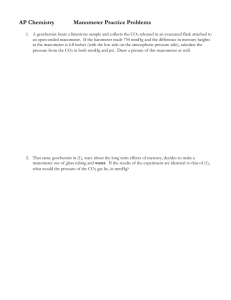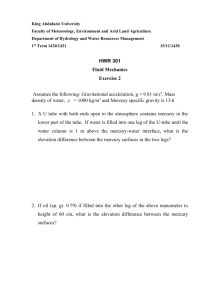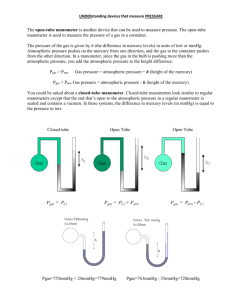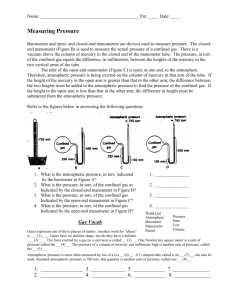pressure
advertisement
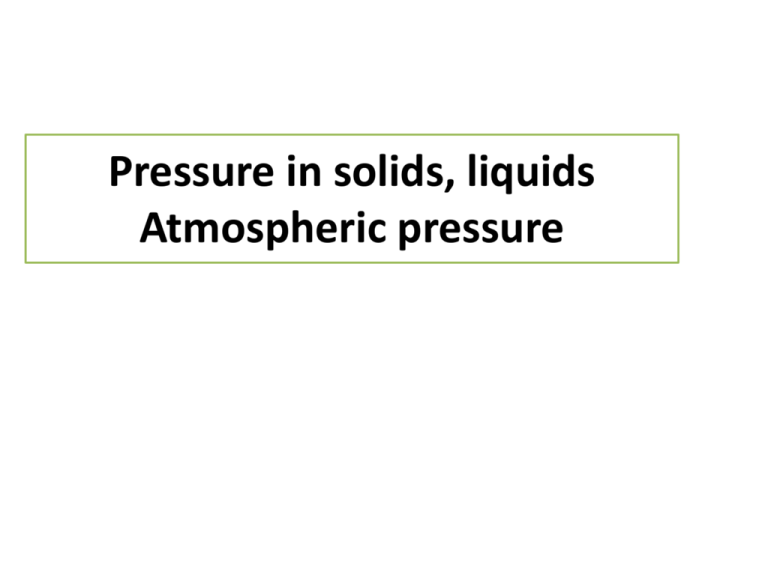
Pressure in solids, liquids Atmospheric pressure Pressure Why do predators often have SHARP teeth and claws? Why does wearing skis stop you from SINKING into the snow? IGCSE Pressure • Relate pressure to force and area, using appropriate examples • Recall and use the equation p = F/A • Relate (without calculation) the pressure beneath a liquid surface to depth and to density, using appropriate examples • Recall and use the equation p = hρg • Describe the simple mercury barometer and its use in measuring atmospheric pressure • Use and describe the use of a manometer Pressure formula and triangle • Pressure = Force / Area • P=F/A • Pa = N / m2 unit Pascal Exercise 1: words to use surface area , weight , pressure, sink 1. Why do tractors have such large wheels? The large wheels have a large surface area in contact with the ground. Tractors have a large weight (force) and often have to work on soft ground like mud and soil. The large area of the tyres means that they put less pressure on the ground and they are therefore less likely to sink. 2. Why do camels have such large feet? Camels are often found in deserts. The camels have a large weight (force) The large surface area of their feet on the ground means that they put less pressure on the sand and are less likely to sink into the sand. Camels have large feet Exercise 2: Pressure Pressure tells us over what sort of area a _____ force is acting. Pressure depends upon two factors: the force that is being applied and the ____ area over which the force is acting. The larger the force, the greater the ________. pressure The ______ smaller the force, the lower the pressure. The smaller the area, the _______ greater the pressure. The larger the area, the smaller the pressure. greater area pressure force smaller Pressure Formula The pressure formula allows you to calculate the pressure, force or area for a problem given two of the factors. Pressure = Force Pressure measured in Pascals (Pa). Area Force measured in Newtons (N). Area measured in metres squared (m2). 1 Pa = 1 N/m² Example A force of 10 N acts over an area of 2 m2. What pressure is created by the force? Pressure = Force ÷ Area Pressure = 10 ÷ 2 Pa Pressure = 5 Pa or 5 N/m2 Exercise 3: Hammer and Nail A hammer is used to drive a nail into a wooden floor. The hammer is brought down with a force of 200 N. The area of the top of the nail is 0.5 cm2. What pressure is put upon the top of the nail by the hammer blow? Pressure = Force ÷ Area Pressure = 200 N ÷ 0.5 cm2 Pressure = 400 N/cm2 Exercise 4: Pressure Calculations 1 1. What are the units of pressure, force and area? Pressure measured in Pascals. Force measured in Newtons. Area measured in metres squared. 2. A force of 500 N acts over an area of 10 m2. What pressure is created by this force? 50 Pa. 3. A girl of weight 400 N has feet of area 100 cm2. What pressure does she put on the ground? 4 N/cm2. 4. A car of weight 6 400 N has four wheels. Each wheel has an area of 80 cm2. What pressure does the car put on the ground? 20 N/cm2. Exercise 5: Pressure Calculations 2 – Pressure worksheet 1. A force of 300 N creates a pressure of 4 N/m2. Over what area is the force acting? 75 m2. 2. A pressure of 200 Pa is created over an area of 5 m2. What force acts to create this pressure? 1 000 N. 3. A tractor has tyres of area 3 m2. It has a weight of 12 000 N. What pressure does the tractor put on the ground? 4 000 Pa. 4. A truck has tyres of area 5 m2. It puts a pressure of 15 000 N/m2 on the road. What is the weight of the truck? 75 000 N. Fluid Pressure The pressure in SOLIDS always acts DOWNWARDS because of the PULL of GRAVITY. In FLUIDS (LIQUIDS and GASES) the pressure acts IN ALL DIRECTIONS. Pressure in fluids can be used to TRANSFER FORCES. Also, in fluids, the PRESSURE INCREASES WITH DEPTH. Less pressure Higher pressure DAMS are WIDER AT THE BOTTOM than at the top because pressure increases with depth in water. Pressure in liquids • • • • acts in all directions it increases with depth it depends on the density of the liquid it is the same at any depth, it does not depend on the shape or width of the container • Demo Pressure in a liquid • To calculate the pressure in a container with a base A filled with liquid of density ρ at a depth h we need to know • Volume of liquid = base area x depth = Ah • Mass of liquid = density x volume = ρAh • Weight of liquid = mass x g = ρ g Ah g = 10 N/kg • Force on base = ρ g Ah This force is acting on area A Pressure = force / area = ρ g Ah =ρ g h A Pressure in water EXAMPLE • If the density of water is 1000kg/m3, what is the pressure due to the water at the bottom of a swimming pool 2m deep? ρ = 1000kg/m3 g=10 N/kg h = 2m p= ρ g h p = 1000kg/m3x10 N/kg x2m = 20000 Pa pressure = 20 kPa Pressure in Liquid • This equation allows us to calculate the pressure at any point below the surface of a liquid due to the liquid alone. • To determine the total pressure at this point, we must add on the pressure value at the water surface which is due to the atmosphere (so is called atmospheric pressure). • Atmospheric pressure varies slightly over the Earth's surface and changes due to weather conditions • The value used for calculations is 100 000 Pa = 1.0 x 105 Pa Total Pressure in liquids Total pressure = water pressure + atmospheric pressure p = ρgh Pa + 100 000 Pa Atmospheric pressure at sea level is 101 325 Pa. Mark scheme Mark scheme Air pressure demonstration The can contains air particles and is also surrounded by air particles. They are hitting the sides of the container on the inside and the outside. The vacuum pump removes the air particles from inside the can. The pressure caused by the particles on the outside collapses the can. Air Pressure • acts in all direction • becomes less as you rise up through it (because there is less and less weight above). • Kinetic Theory – in a gas, the molecules are constantly striking and bouncing off the wall of a container. The force of these impacts causes pressure . The mercury barometer • A mercury barometer can be made by filling a long glass tube with mercury, and then turning it upside down in a bowl of mercury. •The mercury is held up by atmospheric pressure. As the atmospheric pressure varies every day (depending on the weather), the height of the mercury varies. The height of the mercury can be used to predict the weather. Standard atmospheric pressure The height of the mercury is usually 760mm and this is called standard atmospheric pressure (written 760mm Hg), or 1 atmosphere (1 atm). 1 atm 100 000 Pa In weather forecasting different unit is being used 1 millibar (mb) = 100 Pa Standard atm. pressure is approximately 1000mb. Manometer • A manometer is a u-tube containing a liquid, usually water. It can be used to measure the pressure of the gas supply. The higher the pressure the further the water is pushed around the u-tube and the greater height h. How to use manometer In labs manometer is often used to measure the pressure of enclosed gases, one end of the manometer tube is usually open to the atmosphere instead of sealed. Manometer 1 indicates a gas pressure in the container higher than atmospheric pressure. Manometer 2 indicates a gas pressure in the container lower than atmospheric pressure. Notice the difference in the two pressure calculations! Difference between manometer and barometer • Barometer is a type of close-end manometer. • Barometer is specially designed to measure the atmospheric pressure, whereas manometer can also be used to measure the pressures, which are lower than atmospheric pressure. • In a manometer, both ends of the tube are open to outside (some may have a one closed end), whereas in the barometer one end of the glass tube is sealed and it contains a vacuum. Exam questions Useful links LIQUID PRESSURE https://www.youtube.com/watch?v=7m7J5T7c6ig WHY DO OUR EARS HURT UNDERWATER http://scienceblogs.com/dotphysics/2010/03/22/why-do-your ears-hurt-underwat/
